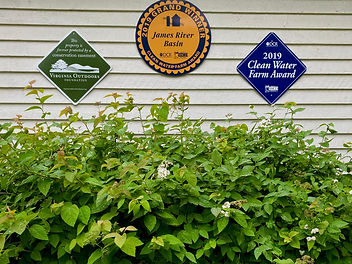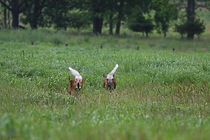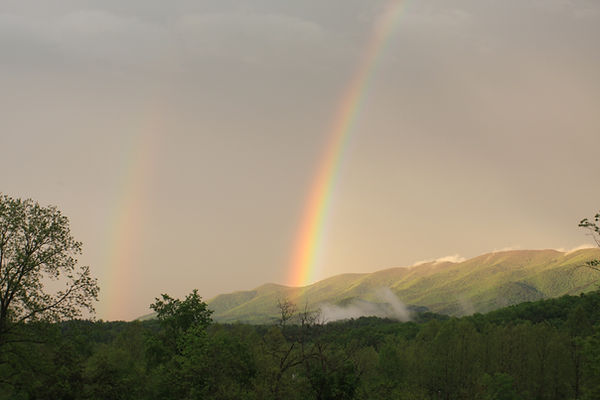
Conservation
The day to day joy of living surrounded by all the beauty and life that is Scott Hollow Farm is profound. For us, restoring this land and then protecting it and its native inhabitants for the future is a privilege. That is why, when we see something that is not as it should be, we work to make it right. It is extraordinarily satisfying work, but we also recognize that as the current stewards, it is our responsibility to leave this farm, and the natural world surrounding it, healthier and more alive than we found it. Below is a brief history of the condition of the farm in 1998 and our efforts to restore the life and sustainable balance of this small piece of the beautiful Virginia highlands. Lois’s pictures document completed projects and/or their results.



Condition of the farm in 1998
At the time Scott Hollow Farm was purchased in July 1998, it had been leased for many years for grazing and growing corn, and parts had been recently timbered. Cattle roamed freely through most of the open land and much of the forest. With only boundary fencing, cattle had unfettered access to the farm’s extensive wetlands, ponds, and the Calfpasture River which flows through the entire property. Over-grazing and the nutrient imbalance from over application of poultry litter was not only impacting the farm’s sustainability but also severely compromising water quality. Wildlife habitat was non-existent. The wetland areas were denuded and void of any life and the banks of the Calfpasture displayed all the adverse impacts of unrestricted cattle access. Clear cutting of steep slope woodlands damaged the root systems that stabilized the shale-based soils, adding to the runoff challenges. In short, the farm, its wildlife habitats, the woodlands, the wetlands, and the river were all in decline.
Restoration Activities:
1998:
-
We stopped the over-application of poultry litter as fertilizer. We temporarily removed cattle from the farm until internal fencing was installed. Timbering on the shale slopes was halted.
1999:
-
34 acres along the river and tributaries were planted with hardwoods.
-
65 acres of bottom land on the east side of the Calfpasture was planted in warm season grasses to create habitat and begin the slow process of returning the soil to a more balanced state.
-
‘100 to ‘300-foot vegetative buffers were created along the river and tributaries.
-
Fences were built along the edge of the buffers confining cattle to very specific non wetland pastures.
-
Springs were developed into a watering system for the cattle.


2000:
-
Approximately 2,000 feet of severely eroded Calfpasture stream bank was stabilized using native rocks from the farm.


2005:
-
An additional 191 neighboring acres was purchased bringing the farm to a total 512 acres.
-
We placed the first restrictive conservation easement on 317 acres of the farm. In addition to extensive water protection measures, the easement prohibited future timbering on the shale slopes.


2008:
-
An additional 60 acres of formerly open but wet cattle pasture was planted with warm season grasses and forbs.
-
A long term effort to install and maintain duck boxes and nesting grasses for other ducks began.

_JPG.jpg)

2013:
-
Fences were installed creating ‘100 vegetative buffers around most of the cattle pastures. These wildlife friendly buffers were planted with warm season grasses, shrubs, forbs and hardwoods.

_JPG.jpg)

_JPG.jpg)
2015:
-
An additional easement was placed on 171 acres on the east side of the Calfpasture.

2018 to 2020:
-
Working with the Nature Conservancy we began planning for the restoration and expansion nearly 50 acres of wetlands on both sides of the Calfpasture. Work on this extensive project is slated to begin in the fall of 2021. Of particular note is the planned restoration of a white swamp oak wetland containing extraordinary populations of amphibians, insects, wild iris, and other species.



2020:
-
Initiated an aggressive rotational grazing regimen that allows us to keep our cattle moving to new pasture constantly. Instead of moving the cattle through nine fields, we can now move them through 26 with no more than two days on each field. This approach will lead to better forage utilization and variety, water absorption, subsurface microbial health, improvement is soil quality, and the holy grail of increased carbon sequestration. Besides all that, the cows love it!!
-
This year we also completed a winter hay-feeding barn that will allow us to capture a good portion of our herd’s winter manure which we will compost and return to our fields to further increase the ground’s soil organic carbon (SOC) content. The greater the SOC the healthier the soil which leads to better forage and even more carbon sequestration.
-
Just in case you might not know, increasing SOC in soils that have been over-used for agriculture and other uses offers tremendous potential to help offset the massive increases in atmospheric carbon dioxide we’ve witnessed over the past 150 years.


Results:
-
Since beginning our conservation efforts in 1999, we have witnessed and celebrated the following results:
-
All wet areas are protected, have returned to a natural vegetative state, and are alive with vibrant and diverse wildlife communities. Ducks are everywhere!
-
Wildlife buffers and planted meadows support all the species known to belong in the upper James watershed. The only significant disappointment is we have been unsuccessful in reestablishing bobwhite quail.
-
The woodlands are recovering and support all manner of native wildlife including many on DGIF’s threatened species list. Most especially, we have a significant population of whip-poor-wills.
-
We are particularly proud of the fact that the Calfpasture River, except for just two miles, is no longer listed as impaired. In addition to our efforts, this is the result of our neighbors along the entire river also placing conservation easements and implementing recommended “best practices”. Now the focus needs to shift quickly to repairing the previously damaged banks and reestablishing the natural water course.



The Future:
-
We will continue our efforts to restore the property’s natural ecosystems, with particular emphasis on the wetland areas.
-
We hope to further our outreach to others facing the challenges of land, wetlands, and upland habitat restoration by offering our plans, efforts and results to those who also believe what we’ve lost can be resurrected.

CONSERVATION TOPICS
_JPG.jpg)




